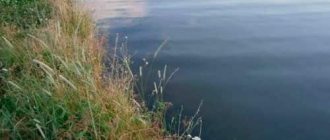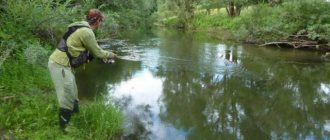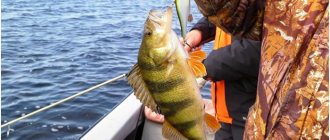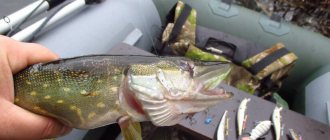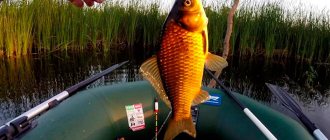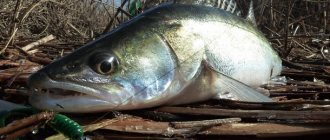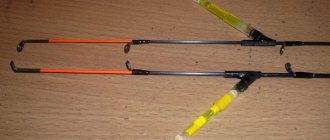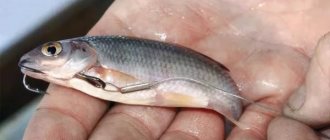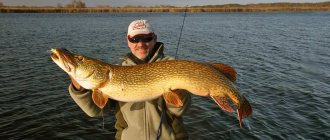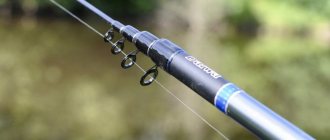Fishing in summer
- admin
- Posted on 08/15/2013
- Summer fishing
- No Comments
Fishing in the summer
is an activity that, at a minimum, can be called exciting.
After the sun rises and warms the water, rudds seek cover under the shade of water lily leaves and white lily. As if in a dream, they stopped in place. If the day is windless and any movement in the water is noticeable, then any thrown bait will scare away the fish. In this case, proceed as follows. From any secluded place on the shore, the bait is carefully placed on a lily leaf and, after a short delay, it is also carefully moved into the water. In most cases, the rudd bite occurs immediately. Summer fishing
When using natural bait (grasshoppers and other insects), fishing in summer
becomes especially successful.
But this fishing method also has some disadvantages. After all, even a thin fishing line gets wet soon enough, after which it sinks and takes the bait with it. For chub or ide, this will seem like a very suspicious factor. How can I avoid this effect? Quite simple. It is enough to coat the entire fishing line with paraffin. Some people prefer to use duck or goose fat. There is no fundamental difference; in any case, the fishing line will not sink. There are times when problems arise with complementary feeding. The first of them is the accuracy of casting complementary foods during fast flowing water. Question two: should I use it all at once or in parts? Experienced summer fishing
advise adding complementary foods in parts, each time the bite subsides.
It is best to divide the prepared complementary food into portions in advance and make balls from it. The size of the ball is a walnut. It is well secured to the hook of the fishing rod and quietly lowered to the chosen place. After the ball reaches the bottom, the hook is pulled out with a sharp jerk of the rod. Some attention should be paid to the bait itself. Inexperienced fishermen tend to think that if they have enough worms, they will be successful. This does not quite correspond to the gastronomic tastes of the fish. Her sense of smell is much more perfect than that of humans. So not every worm can seduce an inhabitant of the depths. First of all, we are talking about its freshness, and, accordingly, taste. To ensure bait quality, it is not recommended to use cans. In them, the worms quickly become lethargic and get a metallic taste. A canvas bag is perfect for storage. It is filled with slightly damp sand mixed with moss and worms are poured into it. When fishing in summer,
it is advisable to store the bag in a cool place and sometimes moisten it with a small amount of water. Summer fishing
Quite often, the inhabitants of a reservoir, especially large ones, bite better at night than during the morning or evening dawn. This happens in places where many people swim and motor boats are used. Many fishermen avoid fishing in such places.
and, after sitting with the fishing rod for a short time, they leave with the conclusion that there are no fish.
But in vain. In such places on a river or lake you need to fish, but at night. fishing in summer,
this rule also applies to shallow water.
There, under the cover of darkness, crucian carp, bream, roach and tench of various sizes come to feed. The best bite begins after dark and lasts until midnight. Then there is a break, and just before dawn the bite resumes. On a large river with a strong current, fishing with a fishing rod from the shore does not bring much results. Bleaks could be a fisherman's catch. But there are certainly other fish there. If you have a boat, there will be no problems with choosing a place. But in its absence, things
are different
fishing in the summer You can try this method. With a float rod, without any haste, walk near the steep bank. On the way there will certainly be small shallows behind the willow bushes and small whirlpools near the collapsed bank. In such places it is worth casting by adjusting the float in depth. The catch here is almost guaranteed. This can be explained by the presence of a high content of food, which is sought by both perch and dace, and roach and silver bream. In such a pool, it’s not a problem to catch a dozen good fish. When the bite stops in one place, you need to find another, then a third, etc. When returning back, be sure to repeat the casts in the old places. When fishing in the summer
, there will be bites there again, because river fish are constantly moving, heading against the current near the shore.
During the feast, pike bite on live bait without much consideration and with great greed. The best time for fishing
in summer is early morning or evening dawn.
This fact is due to the fact that in the heat the pike becomes inactive, it hides in shady places. The pike is also affected by a decrease in the amount of oxygen in the water. But there are exceptions to every rule. And they are successfully used by adherents of pike fishing with spinning rods, as well as by fans of girders and circles. The case concerns the feeding of pike before the start of a thunderstorm. At such moments, the fish seems to come out of hypnosis and zealously scour the pond in search of food. So before the onset of a thunderstorm, hunters of this predator have to be fully armed. This short-term gluttony feeling while fishing in summer
can be partly explained by the fact that powerful gusts of wind and rain cool the water and increase the concentration of oxygen.
Storing fish during summer fishing
If while fishing in summer
The catch at dawn turned out to be good, but it is planned to stay until late in the evening, a dilemma arises about keeping the catch fresh.
There is a good way for this need. In a shaded place on the shore, closer to the water, they dig a hole. Its bottom is lined with nettles or sedges. Then, ball by ball, they place their catch. I'm waiting for the same nettles to be generously laid out in balls. To protect against blue-green flies, it is recommended to make the top ball of the nettle thick. And if possible, cover your “warehouse” with bird cherry branches. When fishing in the summer
, the day is coming to an end, evening is coming and it is almost difficult to catch a spoon.
In such cases, fishermen modify their spinning rods in order to fish for large specimens at night. To do this, the spoon is unhooked and a spinning weight is placed in its place. Slightly above the load, place two leashes with hooks, baiting them with a bunch of worms. This type of gear has its advantages. With the help of the spinning rod itself, the bait falls exactly in the chosen place. In addition, hooking and bringing the trophy ashore is very convenient. Just don’t forget about the reel brake and reliable fastening of the spinning rod. Having once tried fishing in the summer
, many people, although they do not become avid fishermen, are definitely among the adherents of outdoor recreation.
If you liked the article, share it with your friends! Thank you!
lovi-rubky.ru
Make the fish compete
If you don't like to move through the water, but prefer to stay and fish in one place, then make the fish compete. All fish have an opportunistic trait in their behavior, so take advantage of this trait.
We recommend: How to get rid of mosquitoes while camping, fishing and outdoor recreation
Get the fish to compete for food before you start fishing, use lots of small food particles in your bait, or feed them bulk food in small but frequent doses. It is important not to start fishing until the fish have developed a competitive feeding regime.
This process usually takes from half an hour to several hours and is quite effective, but it requires some experience and skill from the fisherman and the selection of suitable bait.
Camouflage when fishing in summer
Since the water has become more transparent in summer than in spring, you need to follow some camouflage rules.
- The fishing line along with the leashes should be the color of seaweed.
- It is desirable for the rod to have a brown or grayish-green color. The fliers and cords of the harnesses should be the same color.
- It is necessary to cast the gear very carefully so that there are as few splashes as possible when casting.
- And the last rule is to move along the shore very carefully.
What are the habits of fish in summer?
When fishing in summer, very often it rises from half-water directly to the surface. At the surface of the water, it eats insects that fell into the water at night. Before daylight, the fish return to the depths and continue to feed.
There are periods when the fish feeds exclusively on insects that are on the surface of the water. At such times, you need to catch fish either with a whip or a float rod, exclusively in the upper layers of the water. Insects that it collects from the surface of the water, as well as the larvae of these insects, are used as bait. The thing is that the fish practically does not react to other baits during this period.
How to choose a place to fish in summer.
And June is a month when you can not only catch a lot of different fish, but also show off your skills and knowledge in this matter. But for this you need to know some features
fishing in summer. For example, you need to be able to determine the depth of a reservoir. This can be done using aquatic plants. Using them you can also determine the composition of the bottom. For example, if a yellow egg capsule grows near the shore, the depth in this place can reach 2.5 meters, the bottom is usually muddy in such a place. Roach, crucian carp, and small rudd like to stay between its stems. If you are interested in larger fish, you need to look deeper.
When the goal of fishing is crucian carp, you need to remember that the amount of oxygen in different layers of water is different, and its amount also changes during the day. If it is hot for crucian carp in the upper layers of water, it descends to deeper places and vice versa. Large crucian carp usually move in search of more oxygen, since they need oxygen more. But small crucian carp are not picky about the amount of oxygen.
And because the stretch is overgrown with grass, summer pike fishing when using spinning baits is getting worse and worse. For this reason, at this time, pike must be caught using girders using live bait. While waiting for a long time for bites on the girders, you can calmly go fishing with a float rod.
Toward the end of June or beginning of July, one cannot miss the emergence of the mayfly at nightfall. At the end of June, using bottom tackle is very effective in catching bream using pasta or lard; you need to cast the tackle far. When using a feeder when fishing for bream, it should be filled with millet with various additives.
Baits for fishing in summer.
The best weather for fishing in summer is considered to be that which is accompanied by light drizzling rain, as well as before a significant cold snap or before rain. In the summer , it is necessary to use various aromatic seasonings to flavor bait and baits. Anise, sunflower and other oils, vanilla, mint, valerian and other aromas cope well with this. If fishing in summer takes place in stagnant water, there is no need to add a large amount of flavorings, as your bait may have the opposite effect. For example, if you are going to use anise oil as a scent, then you usually drip it onto your finger and wipe the leash with it not far from the hook. This amount is enough for fishing for the whole morning.
Fishing for bream in summer.
Fishing for bream in the summer is a very exciting activity. Usually, bottom fishing rods are used to catch bream in the summer. Dung worms are most often used as bait; they are planted in groups of two or three; leeches can also be used. Donks need to be thrown at nightfall throughout the night into places where bream comes out to feed. Usually these are the places where the fish swim from the depths to the bay, not far from the algae. You need to choose a bottom that is not very hard, so that there is as little silt on it as possible. A good bait for bream in the summer at night is crayfish meat during the molting period. The best time to fish is from sunset and throughout the night.
After the spawning is over, on warm days the bream moves throughout the reservoir in search of food. In order to successfully catch bream in the summer, you need to take into account its tastes. For example, on small lakes it feeds mainly on bloodworms, so if you put a worm on a hook, you can expect a bite
all day. In general, bream feed differently in all reservoirs. The difference is not only in what they feed, but also how often. For example, in a small silted lake, the main food of bream is worms and snails. On a large lake, the main food for bream in summer is bloodworms, and the shell is dracena. Everything is much simpler in rivers, especially large rivers, where almost everything serves as food for large bream.
Finding a feeding place for bream is quite simple. If you hear smacking sounds in the grass or quite large bubbles on the surface of the water, it means bream is feeding here.
rybsoveti.ru
I love strawberries and cream, although fish prefer worms. Therefore, when I go fishing, I think not about what I love, but about what the fish loves! D. Carnegie
They catch fish with almost anything that grows, flies, crawls, jumps, or swims. In winter, they are mainly caught using bloodworms, maggots, and jigs. In summer, there is a huge amount of animal and plant baits and attachments; plant baits are used no earlier than the coastal vegetation rises by 70-80 cm. A well-fed fish is often capricious, then offer it the “old-fashioned” baits. Many people have read about them, but to read them is one thing, to test them in practice is quite another. Every bait has its time and place!!!
Worms
Worms are the number one bait for catching fish. They fish mainly in open water; despite their short memory, the fish know that there is no shore worm under the ice!!! From spring to autumn, worms are loved by predatory and peaceful fish, only in hot weather sometimes the bait is ignored. There are many types of worms, earthworms, rain worms, dung worms, crawling worms…. Before fishing, it is advisable to clean them, then the worms are more tenacious and hold well on the hook. One day before, place it in damp moss (it’s good to add sweet clover, wormwood, thyme) or finely chopped mint leaves. This fast, delicious-smelling worm is a real delicacy for any fish. Worms are placed on the hook in pieces, whole, or several pieces.
Grasshoppers
The grasshopper is little used for fishing, although 30-40 years ago fishermen willingly put the grasshopper on the hook of a float rod. Harvesting bait is labor-intensive and not always justified. They fish with grasshoppers in small overgrown rivers and lakes on hot summer evenings, when midges swarm in clouds on the water surface. They bite dace, roach, rudd, ide... Place the insect on the hook of a fishing rod from the head, passing the sting through the abdomen.
Bark beetles
Few people fish with the larvae of bark beetles, although in the spring on small rivers with overgrown banks, dace, bream, perch, ide, roach willingly take the bait... Various beetles lay eggs in wood, where small larvae hatch; fish are especially attracted to bark beetles made from birch dust; this is a very durable bait for catching fish with a fishing rod. They look for larvae under the bark of old but damp coniferous and deciduous trees. The bark beetles are planted by piercing them under the dark head and bringing the point out between the mandibles.
Caddisfly
The larvae of a small butterfly live in streams, small rivers, shallows of flowing reservoirs... The best spring bait for reservoirs where these insects are found. Almost all the fish are caught, a real delicacy for grayling and trout. Caddis flies build long tubes from sand, water debris, and sticks, and wander around the pond with their heads and legs exposed. Shitikas are collected in streams, small rivers with clean cold water, shallows of flowing reservoirs... The larvae attach to stones, branches lying in the water, snags... With an inexperienced eye, it is difficult to spot the shitik. You need to look carefully at the bottom debris, then you can catch the movement. They put a stocking on, or rather several pieces under the head.
Horseflies
When fishing in summer, horseflies, gadflies, and various flies often pester you. Lightly crushed insects are placed on the hook of a float rod, inserting the sting into the chest and out into the abdomen. Fish occupying the upper and middle layers of the water bite on them, and large perch are often caught.
Perlovitsa
In the summer they catch fish using the bivalve shell, pearl barley, which lives in most water bodies. It will not interest lake fish; river fish often end up on the hook of a fishing rod. The pearl barley meat is cut into small pieces, placed on a hook and slightly dried. You should try to fish with all the water shells.
Cancers
Crayfish meat has become exotic, but in reservoirs where crustaceans are found it is good bait. Almost all predatory fish bite on molting crayfish, pieces of neck meat, and claws. Perches, pike perch, pike, catfish love crayfish... Fishing for crustaceans is most successful in the first half of June , when crayfish begin molting. The sting is hidden in the meat.
Dragonfly larvae
The dragonfly larva (nymph) is called a kazara. It lives at the bottom of silted reservoirs and is found among underwater vegetation, sedge roots, and egg capsules. Being a natural food, it attracts large specimens of fish; most cyprinids and perches are caught with it. People start fishing with nymphs in mid-spring; this is an effective bait for retrieving. The most active biting coincides with the flight of dragonflies. The timing of the short-term fish “holiday” is different for each region, on average the end of May and June. Colonies of larvae slowly climb up plant stems and become easy prey for fish. In warm water, collecting dragonfly larvae is quite simple, pull out a bunch of plants and select the larvae on the shore. By this time, the nymphs reach four centimeters and are clearly visible. By the way, bream readily takes dragonfly larvae in the fall. Place 2-3 pieces under the head.
rybachka-iz-karelii.org
Fishing calendar
June. In June, it is best to fish in shallow reservoirs, where the water is already warmed up; it will also bite well on small rivers. The best bait for this period of summer is a maggot or a worm. If you are fishing only for large fish, then they need to be planted in 5-6 pieces. It is also worth noting that starting from June it is allowed to catch predatory fish species using spinning tackle and buoys. It is also allowed to catch bream, but only with bottom tackle .
July. This month is the hottest, so the fish will be most active in the early morning and late evening. When fishing during the day, you shouldn’t count on a big catch. In small reservoirs with stagnant water, it will be almost impossible to provide yourself with even a minimal catch. Due to the high temperature, the pond will begin to bloom, which will provide a large amount of food for the fish. The best days for fishing in July are cloudy and rainy days. At this time it comes to the surface. The most productive fishing will be with a spinning rod.
August. In August, the days become shorter, and underwater inhabitants go to the bottom again. Predators bite best at this time. Around the beginning of August, mayflies, the favorite bait of insectivorous fish, begin to emerge. This period lasts 2-3 days, and it is almost impossible to catch fish during this time. To provide yourself with at least some catch, you need to catch a mayfly, which is not easy to do, and put it on a hook.
Fishing in different months of summer
June: the longest days are in this month, and this cannot and does not affect the behavior of the fish. The fish's activity time increases by 10 hours. People said that the main bite begins when the apple, lilac and rowan trees bloom. With the onset of heat, the bite certainly decreases, usually this happens in the last week of June, when the strawberries ripen. 4-5 days after the rose hips bloom, which happens on average at the beginning of the second ten days of the month, pike perch begins to spawn, and its biting stops during this period. For some fish species, spring spawning has not yet ended, and therefore, for many fish species, feeding and biting occurs after spawning. In June, crucian carp, tench, gudgeon, rudd, chub, bleak, catfish and other fish spawn.
July: When full summer has already arrived, the conditions for fishing are not the most comfortable, many negative factors appear for the fish, for example: the water begins to bloom and visibility in the water greatly deteriorates, interfering with the breathing of the fish. The warmer the water, the less oxygen dissolves in it, which also has an adverse effect on fish. In hot weather, the bite shifts to the cooler part of the day, this is one of the main reasons why fish switch to nocturnal and semi-twilight feeding.
In Rus' they always said: it’s a hot July and you don’t care about fishing. According to popular belief, the heaviest amount of precipitation falls in July. By focusing on phenological landmarks in July, you can learn about their condition, behavior, and bite. One of the main phenological signs in July in the European part of Russia is the flowering of linden, which usually occurs at the end of the first or beginning of the second week of the month. Burdock will also help us with the forecast, which will bloom approximately 3-4 days after the linden tree, and after another 5-6 days, winter rye will ripen, followed by tansy, and then potatoes. Now, if we connect these signs and the behavior of the fish, it turns out that at this time the spawning of some species of fish is still ongoing, and a week before the linden blossoms, spawning of crucian carp and pike perch stops. While the potatoes have not bloomed, carp and tench are still spawning. Bleak and catfish spawn almost all month long. The following fish should bite well almost all month long: perch, ruffe, gudgeon, roach, chub, ide, rudd, bleak, catfish, carp and other fish. Tansy and potatoes have not yet bloomed, the bream and bream will be hungry, the crucian carp will bite well, but somewhere in the middle of the month and for about two weeks its bite will not be so intense. During spawning, the tench will peck very weakly, and as soon as the potatoes bloom, the pecking should stop altogether. Also at the same time, the bite weakens for bream, white bream, and silver bream.
August: There are many hot days in August, which will also affect fishing. The first half of August can be safely attributed to summer, because the weather is still hot, and the second half can be attributed to autumn, because the first signs of the onset of autumn are already beginning to appear, for example, at the beginning of the 3rd week, birds begin to fly south, in the middle of 4 weeks the leaves begin to fall, the weather also begins to get colder, cold winds begin to blow, the mornings become cold. The heather is blooming, the hazelnuts are ripening. In August, the bite is observed when the birds fly away. There will be pike perch, bream, and white bream biting. As the leaves begin to turn yellow and the apples ripen, the pike and burbot bite will begin, and with the beginning of leaf fall, the tench begins to take well, and the rudd bite weakens somewhat. At the end of the month, when the heather blooms and the hazelnuts ripen, the carp's bite will worsen. All month long, perch, gudgeon, roach, chub, dace, ide, roach, asp, trout, and grayling will bite well. But the best bite will be catfish and bleak.
Different levels of oxygen in water
In bodies of water and places on a body of water where there is a lot of vegetation, there are daily cycles of oxygen concentration that greatly affect the behavior of fish and their feeding.
Plants, through the process of photosynthesis, release oxygen, therefore, on clear sunny days, plants actively release oxygen and its concentrations increase during the day and usually by the middle of the day are close to saturation of the water with oxygen.
At night the situation is completely different; photosynthesis stops along with the release of oxygen into the water. Since plants, fish and many other microorganisms actively consume oxygen, this means that the level of oxygen in the water drops during the night and reaches a minimum by dawn.
The fish have adapted to this phenomenon and change their behavior within a day. Therefore, in places where there is vegetation, fish are often at the surface at night or at dawn, but unfortunately at this time they do not always feed.
This explains the phenomenon during night summer fishing when the fish are splashing around, and it seems that it is active, but there is no bite, most likely the reason for this is the fluctuation in oxygen levels.
The only advice on what to do in this situation is to change the place of fishing, or go to sleep.
These were the main reasons why fish bite poorly in the summer, even when it seems that it is active. Unfortunately, the fisherman cannot influence them, since these are natural processes, but we will give some more tips on how to activate the fish’s bite in the summer:
Features of summer fishing
So, now let's talk about the general principles of summer fishing. It is best to fish at the mouths of rivers, with riffles and a sandy bottom on the border between calm water and strong currents. In these places, when the rivers return to their channels, the early bite begins. Usually at this time minnows, roaches, and ide begin to be caught. These fish bite very well on bloodworms. A common method for summer fishing is to fish with live bait. The fry should be kept in a jar with air holes in the lid. If the fry are not comfortable, then they quickly die; this bank must be kept in water to prevent overheating of the water in which the fry are located.
With all the variety of methods and techniques for summer fishing, bait made from steamed grains of corn, pearl barley, peas or wheat is especially good. The soaked grains need to be boiled overnight for 20-30 minutes, then you need to pour it all into a thermos and in the morning the already steamed grains will be ready.
Now let's talk about where which fish prefer to be. For example, pike perch loves snags and holes, weak currents and deep pools that border sandbanks in order to prey on small fish. Roach loves the border between thickets of grass and clean water, as well as in the spaces between thickets, in the current, on a sandy bottom, but most often in the vicinity of dense thickets of underwater algae. The chub often lives under steep banks and under bushes hanging over the water.
Train and lure fish
In summer, fish actively move around the reservoir and often return to the same places. Use this property to your advantage.
If you fish with a spinning rod, then fish in the same places at the same time, this way you will accustom the predator to your bait and eventually he will begin to respond to it. This can work for days or even weeks if there is a lot of predator in the area.
We recommend: How to change a rod tip
Having chosen a suitable place, start giving complementary foods at the same time; over time, the fish will build its own behavior pattern and will approach this place at this time to feed.
For bait, do not use a large amount of bait, use granules and microgranules, or large fractions and scatter them along the bottom of the reservoir so that the fish spend hours digging along the bottom of the reservoir.
Share link:
General description of fish
Fish nutrition
According to the type of food, fish are divided into peaceful fish and predatory fish. Peaceful fish are divided into carnivores and herbivores.
Predatory fish - pike, pike perch, perch, asp, burbot, catfish and others feed on fish. Animal-eaters - bream, ide, sabrefish, roach, carp, bleak, dace, ruffe - feed on zooplankton - small crustaceans, worms, mollusks and other living creatures. Herbivorous fish include grass carp and silver carp; they feed on aquatic plants. This division is very arbitrary, since, for example, bream and sabrefish can hunt for fry in the fall, and pike, pike perch and perch can be caught well with a worm. Roaches in summer feed on plant foods. All fish, including predatory ones, being fry, feed on plankton.
The feeding pattern of fish varies depending on the time of year. For example, roach eats insect larvae in winter and spring, switches to greens in summer, and feasts on shellfish in the fall.
As for all fish, in winter they feed poorly or not at all. During the winter, fish process the fat accumulated in the fall. In the spring, the fish bite improves significantly, the fish eat off before spawning. During spawning, the fish do not bite. A week after spawning, the fish begin their post-spawning feast, and the fish regain their strength. In summer, especially in the heat, the bite weakens. The fish feeds at dawn and at night. In the fall, the autumn feast begins; fish, especially predatory ones, gain fat for the winter. This rule applies to all fish, with the exception of burbot and salmon.
In general, the nature of fish nutrition depends on the presence of one or another food in the reservoir. Fish are better caught on what they usually feed on at the time. It is useful to cut open the belly of the first fish caught for scientific purposes and examine the contents of the intestines. A tightly packed intestine indicates that the fish is currently feeding intensively; an empty intestine indicates a lack of food. In both cases you can count on a good bite.
What weather is bad for fishing?
Most of all, fish do not like severe frosts or heat. It ceases to be active and lies to the bottom. Strong wind or rain can interfere with the bite. During such periods, the inhabitants of the reservoir are also in no hurry to rise to the surface, but wait out the bad weather in calmer places.
However, experienced anglers believe that there is no such thing as bad weather for their favorite hobby. You just need to know where the fish are hiding. In bad weather, it can accumulate at depth, so it’s worth taking a boat and going out to the middle of the pond.
In strong winds and currents, representatives of the fauna hide near the shore in the mud or plant roots. That's where you need to sit down with a fishing rod.
At the same time, near the surf coast, especially on steep clayey shores, there is intense erosion of the coastline and a rise in turbidity there. The erosion of insect burrows (mayfly) attracts herds of carp fish to the surf shore.
Sometimes anglers underestimate the influence of wind on the behavior of fish, and downplay the importance of wind when predicting the bite for an upcoming fishing trip, focusing mainly on the dynamics of changes in atmospheric pressure. But in fact, the wind always makes the most significant adjustments to the fish’s behavior and bite. In addition, based on the nature of the wind, almost anyone who monitors the weather can predict its changes and make a forecast for the bite.
Wind arises due to different heating of the earth's surface by the sun and different atmospheric pressure at different points on the Earth. Huge masses of air begin to move, moving from high pressure to low. Depending on where the wind originates, these air masses can be cold or warm, dry or wet. And the speed of their movement is determined by the difference in atmospheric pressure and the distance between the points of movement.
How does wind affect fish bite?
The influence of wind on fish behavior must be considered from several perspectives simultaneously.
The north wind destroys the bite of carp fish
We can say that warm southern winds, in general, have a beneficial effect on heat-loving fish, but “instill” apathy on cold-loving fish. Cold winds in summer have different effects on the bite of different types of fish.
Western winds with rain - for good fishing
The western summer high with rainy weather and moderate cooling is known to be the best time for fishing. Pecking in hot weather is not a rare occurrence. A moderately cool wind after the summer heat leads to a slight cooling of the water. But this state of affairs only activates the fish. This phenomenon is associated with a lack of oxygen in warm water. Wind and rain mix the layers of water and saturate it with oxygen, significantly activating the fish, despite a slight decrease in water temperature.
The air blows away the food for the fish
An interesting observation is related to the influence of wind in summer on fish food. The wind blows large numbers of insects into the reservoir from fields and trees. At the same time, fish feeding on the top (chub, rudd) usually accumulate near the leeward shore. Juvenile fish also head here, looking for peace and food in the quiet, and therefore, a predator will follow them into the leeward bay.
At the same time, near the surf coast, especially on steep clayey shores, there is intense erosion of the coastline and a rise in turbidity there. The erosion of insect burrows (mayfly) attracts herds of carp fish to the surf shore.
A steady and fairly strong wind always redistributes the food supply and affects the movement of fish and its bite.
Accumulation of algae in a wave - lack of bite
It is also necessary to pay attention to the possible negative effect of wind on the bite in certain places of the reservoir, associated with a deterioration in the oxygen regime. The fact is that during water blooms, a large number of tiny algae blown by the wind can accumulate in the backwaters on the surf shore. The subsequent death and decay of this organic matter leads to a lack of oxygen, and as a consequence, to the complete absence of fish in such a bay.
Heating of water and currents under the influence of wind
The wind has the strongest influence on the reservoir in cold times - in autumn and spring. A warm breeze in such a season significantly warms the water, while the water heated by the sun and wind will be driven to the surf shore. It goes without saying that a meeting with carp fish is most likely there, but what’s more, this time cold-loving pike, pike perch and perch will follow the schools of roach and rudd there.
Thus, directly on the reservoir it is always useful to analyze those changes in the temperature pattern of the water and the movement of food that could be caused by the current wind, as well as that which was present several days before fishing.
Ebbs and flows of the seas
In the coastal zone of the seas, significant fish migrations are associated with the wind. In the Sea of Azov, pike perch, which prefers brackish water, enters deeper into estuaries and channels, when the wind blows from the sea, which pushes salt water into the estuaries. When the wind blows from land, the pike perch goes back to the sea, and species that live in the fresh water of estuaries appear in the channels at the border with the sea.
How does wind force affect the bite?
In general, there is no doubt that anglers who carefully monitor the wind, and correctly assess its effect on the behavior of the fish and on the body of water, will have a better chance of successful fishing and a good bite.
You can expect good fishing after the wind stops. Waves hitting the shore wash away food and fish such as bream will definitely come to the shore to feed. For anglers, this is exactly the case when you can catch a good bream.
